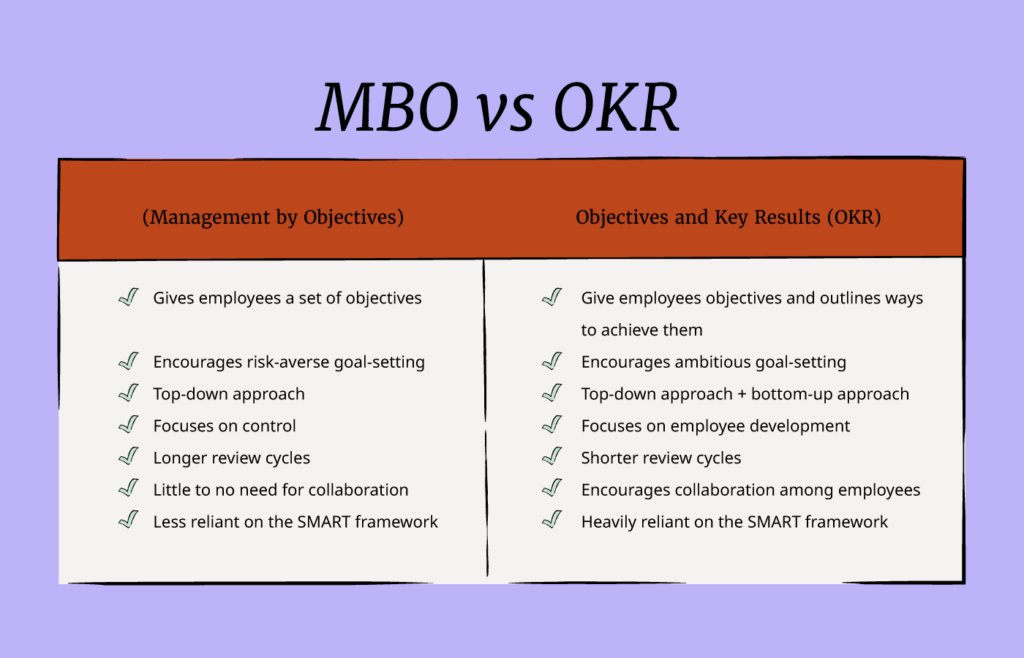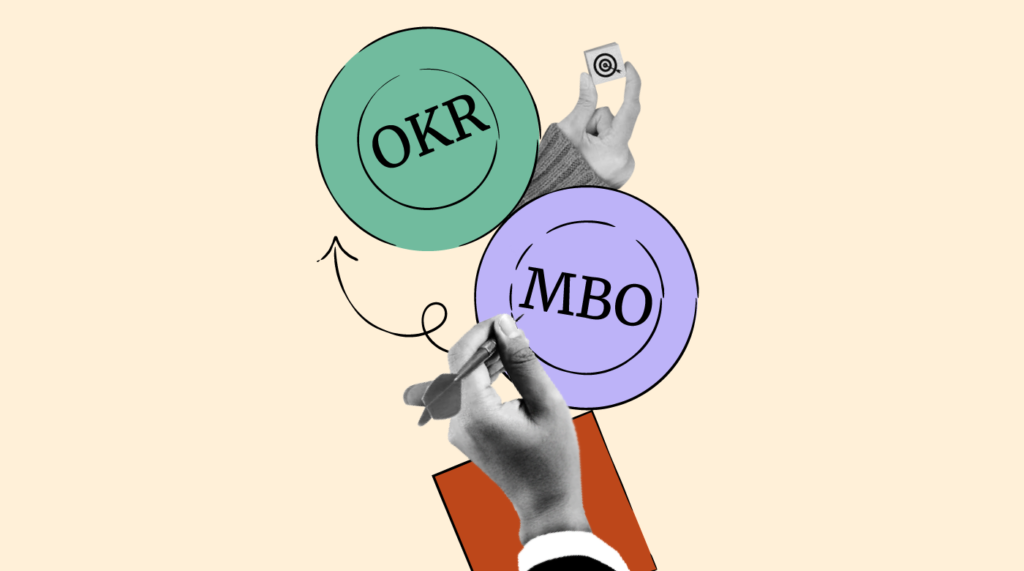Navigating the maze of management strategies? Two standouts, Management by Objectives (MBO) and Objectives and Key Results (OKR), offer distinct paths to goal alignment and team success.
MBO hones in on individual goals aligned with organizational aims, while smart OKRs target ambitious, measurable outcomes. This article demystifies these approaches, hopefully helping you in choosing the right fit for your company's vision.
What Is MBO?
MBO (Management by Objectives) is the process for setting objectives for individual employees that are connected to high-level organizational objectives.
An organization outlines its high-level objectives and then employees and managers work together to set individual goals that contribute to it.
This way, individual goals are tailored to the competencies of the employee and are deemed to be achievable. When employees achieve their objectives, they commonly earn a bonus.
The reason for this collaboration is to encourage motivation and commitment from employees to meet objectives.
A typical MBO cycle lasts 12 months, throughout which employee progress is monitored.
Performance management is a key element of MBO because managers need to assess how far the objectives have been achieved. However, in the absence of a performance measurement framework, assessment can become tricky.
Regardless, when an employee doesn't achieve a certain objective, it's important to provide them with constructive feedback and help them achieve goals over the next MBO cycle.
MBO Example
For instance, if your goal is to improve the company’s customer service, you can set objectives such as:
- Quicker response times
- Smoother onboarding
- Proactively reaching out to customers offering help with new features.
Even though the objectives can help achieve the goal, what’s lacking is a way to measure progress or how the objectives should be achieved.
Enter OKRs.
What Is OKR?
OKR is a goal-setting framework that builds on the MBO method by outlining how an objective should be achieved.
"Objectives" outline what needs to be achieved.
"Key Results" (typically 3-5) provide clarity on how those objectives will be achieved.
OKR relies heavily on the SMART criteria to ensure that objectives are specific, achievable, and quantifiable.
The OKR methodology was introduced by a former Intel CEO Andrew Grove in the '80s.
“Figuring out what to do is important. But doing it and doing it well is equally important,” said Andrew Grove, former CEO and Co-Founder, Intel.
John Doerr, an early Google investor, liked the OKR approach and implemented it at Google. Doerr is credited for popularizing the approach among the management community.
Like with MBO, OKRs work on all levels and help create alignment on objectives throughout an organization.
But, unlike with MBO, OKRs are made accessible to all team members. This transparency facilitates collaboration among employees.
Also, OKR eliminates any monetary benefits to employees for achieving the objectives.
Finally, OKRs are generally used more flexibly and are either committed, aspirational, or learning-focused.
OKR Example
For instance, if your objective is to improve customer satisfaction by 5%, you can use the following Key Results to measure progress:
- Reduce the time customers have to be on hold when calling support by 10% by increasing the number of support staff by 15%
- Inform more existing customers about deals and discounts by increasing the number of outbound channels from 2 to 4
- Minimize the time callers have to spend navigating the IVR (Interactive Voice Response) by 20% by reworking the IVR framework
We’ve got more HR OKR examples if you’re looking to gain a deeper understanding of how you can use OKR for HR purposes.
MBO vs OKR
Here’s a breakdown of the key differences between MBO vs OKR:

1. The “what,” vs. the “what + how”
The primary difference between MBO and OKRs is that OKRs go a step further and tell employees how they can achieve their objectives.
MBO states the broader goals of the company, but doesn’t provide a framework for measuring progress. It doesn’t offer any insight into how employees can achieve their objectives either.
OKRs also state how objectives can be achieved and measured. Managers can provide objectives, define milestones or “key results,” and give employees insight into how they can achieve an objective.
2. Risk averse vs. ambitious goal setting
MBOs are tied to bonuses and other forms of compensation. When an employee doesn’t achieve objectives, they’ll get less bonus money.
It’s easy to see how this can encourage employees to set safe, easily achievable objectives. Less risky objectives means always getting bonuses.
OKRs eliminate the issue because the achievement of objectives has no influence on an employee’s compensation. Since there are no monetary consequences, OKR encourages employees to set ambitious objectives.
Achieving 60%-70% of ambitiously set objectives is still better than achieving 100% of safe objectives. When employees achieve less than a 100% of their objectives, they feel challenged and feel encouraged to innovate.
Where’s the fun in achieving all your goals easily, anyway?
3. Top-down vs. top-down + bottom-up goal setting
Under the MBO approach, goal-setting happens at the executive level. Executives formulate a set of objectives based on the company’s goals and assign them to relevant employees and departments.
The same also happens under the OKR approach. But it also gives employees the freedom to set their own objectives that align with the company’s or their department’s goals.
Therefore, OKR allows setting bottom-up goals, driving employees to achieve more.
4. Control vs. employee development
MBO, though still used widely, follows traditional management philosophy. Management sets objectives annually and monitors if employees are working towards achieving them.
However, OKRs offer employees a tactical path to achieving their objectives. Management measures the goal achievement for each individual employee and should provide weekly feedback during the OKR cycle, as well as retrospectively.
The feedback loop and collective efforts emphasize employee development over achieving all of the objectives.
5. Longer vs. shorter cycles
MBOs are typically reviewed annually. Several variables (company’s immediate goals, priorities, etc.) can change by the time an MBO cycle comes to an end.
OKRs typically take a quarterly cycle. They allow more room for adapting the objectives to the company's evolving needs.
With OKR, teams discuss their progress weekly, giving members the opportunity to pivot with evolving or unexpected situations.
6. No need for collaboration vs. encouragement for collaboration
MBO helps managers ensure that all employees have the company’s broader goals in mind.
Managers oversee, measure, and control goal achievement once they have set the objectives. Beyond this point, MBO is an individual level phenomenon. Employees then focus on their objectives with little to no need for collaboration.
OKR allows a team level approach since it’s more transparent. They allow all employees access to the progress of a team member’s objectives, encouraging collaboration where needed.
The transparency also allows ongoing feedback where the entire team can provide inputs about how they’d solve a problem or work towards achieving an objective more effectively.
7. Reliance on SMART goals
MBO is more flexible and open-ended in the respect that managers can use qualitative, quantitative, or both factors to measure employee performance.
OKRs emphasize quantitative measurement because they rely on the SMART criteria for setting goals.
Setting goals that are specific and measurable requires quantifying the goal before they’re assigned, so there’s always an underlying scoring model to measure the progress of OKRs.
Be Future-Ready With OKR
Both the MBO and OKR goal-setting frameworks are used by many successful organizations.
Today, many organizations are adopting OKR because they’re deemed more detailed and flexible.
They’re capable of providing teams and individuals an engaging framework to measure their success and driving performance.
They’re dedicated tools for setting, tracking, and measuring goals at scale. OKR software streamlines the process of implementing the framework and helps build tracking into the everyday workflow.
If you’re keen on using OKRs at your company, you'll need to get buy-in from senior leaders. For further guidance on utilizing OKRS, check out our shortlist of the best OKR podcasts.


